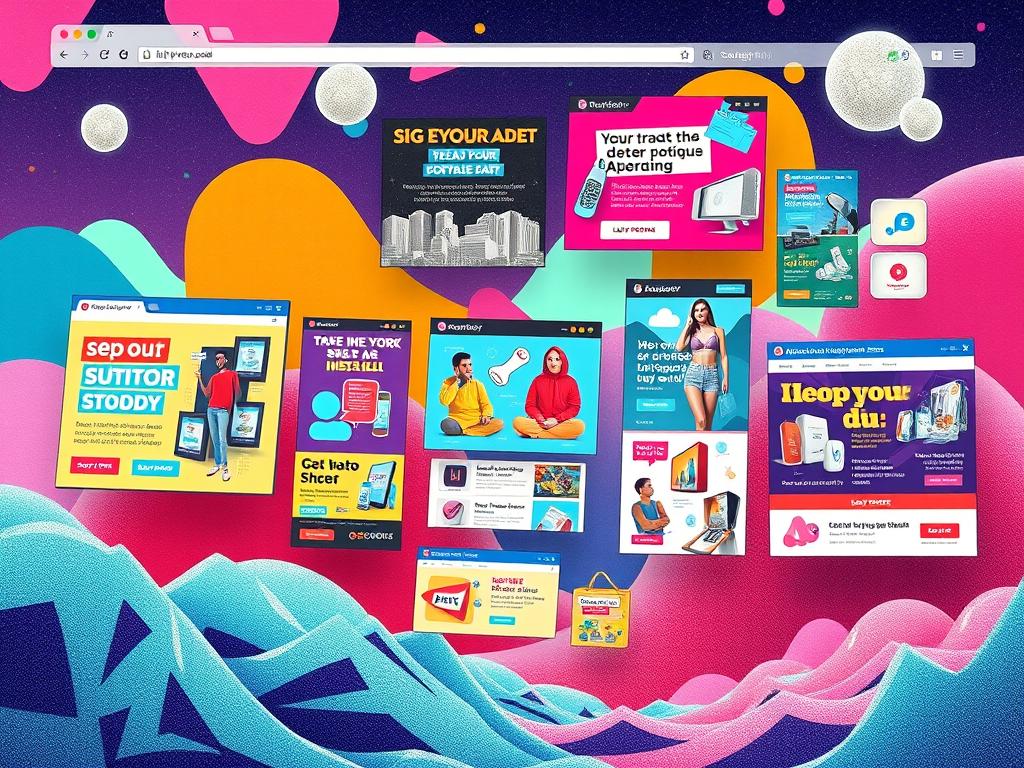In the dynamic world of marketing, advertising evolution has undergone profound changes over time. From hieroglyphics in ancient Egypt to the first print ad in 1472, and from 1704’s newspaper ads to the introduction of billboards in 1835, advertising has continuously adapted to new mediums and audiences. The marketing history saw a significant leap with Sears’ direct mail campaigns in 1892, embodying the first steps towards personalized ads. Today, the digital transformation in advertising utilizes vast amounts of personal data, evidenced by Facebook’s 215.6 billion data points and Google’s extensive data collection, to tailor unique marketing experiences for consumers. The shift from early print to today’s digital formats has revolutionized consumer engagement and advertising practices.
With brands increasingly focusing on agile advertising strategies, there is a significant shift in production times and costs, enhancing both revenue and market share growth. Statista reports show that while traditional TV advertising is being eclipsed by social media and mobile ads, platforms like TikTok now offer brands an average organic reach of 118%, proving to be a strong conversion channel. This digital transformation in advertising is driven by the prevalence of over six billion smartphone users globally, who receive advertising content through various digital and social media channels, making personalized and data-driven advertising more important than ever.
The Early Days: Print and Radio Advertising
The inception of advertising can be traced back to the 15th century, with the first recognized print ad appearing in England in 1472. The print advertising history further evolved when newspaper advertising surfaced in the United States in 1704, and by 1835, billboards started spreading information with impressive circus posters exceeding 50 sq. ft. Significantly, in 1836, the Paris newspaper La Presse emerged as a pioneer by leveraging paid ads to reduce its price and broaden its readership.
The First Print Ads and Their Evolution
Print advertisements progressively infiltrated public consciousness and held a critical role in marketing evolution. By the 19th century, companies like Cope Bros & Co started using extensive advertising to dominate their markets. Notable figures such as T. J. Barratt of Pears Soap in 1908 further revolutionized techniques, earning the title “the father of modern advertising.” Furthermore, advertising volume in the U.S. surged from $200 million in 1880 to nearly $3 billion by 1920, reflecting the growing importance of this medium.
The Rise of Radio Advertising in the 1920s
The 1920s marked a pivotal moment with the advent of radio commercials. The first recognized radio advertisement aired in 1922, hosted by H.M. Blackwell, introducing innovative indirect methods to engage listeners. This era was transformative for the marketing evolution, embedding radio into the societal fabric. Despite technological leaps and shifts in consumer behavior, radio continued to be a potent platform. During World War II, radio commercials played a significant role in public morale and information dissemination, securing their place as a timeless marketing tool.
The continuous drive for professional status and ethical recognition among advertising professionals further amplified the importance of both print and radio advertising in the broader narrative of marketing evolution.
The Golden Age of Television Advertising
Television marked the “Golden Age” of advertising in the early 1900s, allowing direct engagement with viewers. This period saw significant advancements and transformations in how brands connected with their audiences through television commercials, iconic ads, and celebrity endorsements in advertising.
The First TV Commercials and Their Impact
In 1941, Bulova Watch Company heralded a new era with the first television commercial. It was a game-changer, setting the stage for brands to enter American living rooms. By 1946, only 8,000 US homes had TV sets, but this number exploded to 45.7 million by 1960. This exponential growth underscored the unparalleled reach and influence that TV commercials could wield. Advertising spend in the UK mirrored this trend, jumping from £10 million in 1956 to £86 million in the 1960s.
The Role of Iconic Characters and Celebrities
As the decades rolled on, the role of iconic ads became more pronounced. Characters like Tony the Tiger and Ronald McDonald were introduced to humanize brands and foster connections with consumers. Celebrity endorsements in advertising also soared, making it a norm rather than an exception. Brands realized that familiar faces could drive trust and loyalty. However, not all characters were free from controversy. For instance, the Frito Bandito character led to a $160 million class-action lawsuit for racial defamation.

The Shift Towards Storytelling
From the 1960s to the late 1980s, storytelling took center stage in TV advertising. Instead of focusing solely on a product’s Unique Selling Point, advertisers began to create emotionally resonant narratives. Campaigns like the Milk Tray Man and Cadbury Flake Girl became iconic ads. Emotional advertising messages aimed at youth with disposable income became more prevalent. Ronald McDonald and other characters began appearing, promoting senses of joy and brand loyalty that transcended generations.
Television commercials also adapted to technological advancements over time. The introduction of TiVo in 2000 allowed viewers to skip ads, urging companies to innovate in how they reached their target audiences. With the rise of streaming services like YouTube, Netflix, and Hulu in 2010, there was a shift towards Over-The-Top (OTT) and Connected TV (CTV) advertising, indicating a dramatic shift in advertising strategies. By 2022, streaming services overtook traditional cable television, revolutionizing the landscape and highlighting the need for more targeted and personalized ad campaigns.
| Year | Advancement | Impact |
|---|---|---|
| 1941 | First TV commercial (Bulova) | Initiated the era of television advertising |
| 1960s | Rise of Character Adoption and Emotional Storytelling | Strengthened brand loyalty and emotional connections |
| 2000 | Introduction of TiVo | Changed ad viewing behavior, prompting innovative advertising methods |
| 2010 | Popularity of Streaming Services | Shifted focus to OTT and CTV advertising |
| 2022 | Streaming Surpasses Cable TV | Revolutionized advertising with targeted and personalized campaigns |
Personalization in Advertising: From Direct Mail to Digital
Personalization in advertising has evolved extensively over the years, shaping the way businesses engage with consumers. It began as early as 1892 with Sears’ direct mail campaigns, where they sent out 8,000 postcards and secured 2,000 new orders. This demonstrated the power of reaching potential clients directly through their physical mail.
Personalized marketing took a significant leap forward with the development of the unique selling proposition (USP) by Rosser Reeves and market research innovations by George Gallup. These advancements allowed advertisers to fine-tune their messages to specific audiences, fostering deeper connections and ultimately enhancing customer loyalty.
The digital advertising innovation era brought unprecedented levels of personalization. Platforms like Facebook, with its 2.2 billion users, collect 98 personal data points per user—adding up to a staggering 215.6 billion data points. This immense data ecosystem allows for incredibly tailored marketing efforts. Similarly, Google’s extensive data collection capabilities encompass everything from location and search queries to app usage and calendar events.
As digital platforms became more sophisticated, the ability to deliver hyper-segmented or one-to-one marketing emerged in the 1980s, further revolutionizing personalized marketing. Companies now leverage cookies and other data collection methods to create detailed user profiles. This approach paved the way for targeted ads, such as search ads and display ads, which align with user inquiries and preferences.
Email marketing exemplifies the modern era’s advanced personalized marketing techniques, as it utilizes volunteered information from consumers to segment and tailor ad campaigns. On the other hand, direct mail campaigns can still target consumers based on location without explicit consumer consent, continuing to be a viable marketing strategy.
The sheer volume of data collected by companies like Google is immense—enough to fill 569,555 sheets of paper annually, stacking up to more than 189 feet. This data is crucial for crafting personalized marketing experiences that resonate with individual consumers. Additionally, the impressive click-through rate of the first banner ad by AT&T in 1994, where approximately 44% of viewers clicked on it, underscores the efficacy of well-targeted digital ads.
Overall, the journey from direct mail campaigns to hyper-segmented digital advertising showcases the tremendous strides made in personalized marketing. This progression not only reflects advancements in technology but also highlights the continually evolving strategies used by businesses to connect with their audiences meaningfully.
The Advent of Internet Advertising
The world of advertising saw a revolutionary shift with the rise of the internet. With the introduction of the first banner ad by AT&T on HotWired in 1994, achieving an impressive click-through rate of 44%, it marked the dawn of a new era. This innovation paved the way for various advancements and laid the foundation for a dynamic digital advertising landscape. From the rise of banner ads to the sophisticated world of pay-per-click advertising and keyword targeting, internet advertising has continuously evolved to meet the needs of both brands and consumers.

Birth of Banner and Pop-Up Ads
The initial introduction of banner ads was a game-changer. By 1995, WebConnect introduced targeted ad placement, allowing brands to reach specific consumer demographics by placing more relevant ads on websites frequented by their target audiences. To combat “banner fatigue,” WebConnect’s CustomView tool limited the number of times a user saw the same banner ad. In 1996, Doubleclick’s D.A.R.T. tool enhanced campaign performance by enabling real-time tracking of ad views and clicks across multiple sites. This tool, along with the Cost per Impression (CPM) model, shifted the focus toward an ROI-based pricing strategy.
The Shift to Search Engine Advertising
Search engine advertising significantly changed the advertising landscape. By 1999, GoTo.com pioneered the first pay-for-placement search engine service, which eventually evolved into the pay-per-click model. This allowed brands to bid on search result placements on a per-click basis. Google followed with AdWords in 2000, introducing a quality score model that considered an ad’s click-through rate, ensuring that relevant ads appeared higher in search results regardless of the bid amount.
Introduction of PPC and Keyword-Based Ads
The advent of pay-per-click advertising and keyword targeting in the early 2000s revolutionized digital marketing. Google’s AdWords set the standard by integrating a quality score to ensure ad relevance and user satisfaction. By 2006, Facebook shifted its advertising strategy to focus more on targeted ads based on user demographics and interests, emphasizing the importance of quality content and precision in advertising. This precise targeting approach allowed marketers to deliver the right ads to the right audience, optimizing both engagement and conversion rates.
| Year | Milestone | Impact |
|---|---|---|
| 1994 | Launch of the first banner ad by AT&T | 44% click-through rate, setting a high standard |
| 1995 | Introduction of targeted ad placement by WebConnect | Increased relevancy and reduced banner fatigue |
| 1996 | Doubleclick’s D.A.R.T. tool | Real-time tracking and better ROI measurement |
| 1999 | GoTo.com’s pay-for-placement service | Birth of the pay-per-click model |
| 2000 | Google’s AdWords | Ad relevance improved with the introduction of quality scores |
| 2006 | Facebook’s focus on targeted advertising | Enhanced precision and engagement in ad campaigns |
| 2019 | Total ad spending reached $333.25 billion | Continued growth and investment in digital advertising |
The journey from the early days of banner ads to the sophisticated strategies in pay-per-click advertising and keyword targeting highlights the dynamic and ever-evolving nature of internet advertising. As technology advances, so do the methods for connecting brands with their audiences, making the digital advertising field a constantly evolving landscape full of opportunities.
The Rise of Social Media Advertising
The advent of social media marketing in 2008 revolutionized advertising by focusing on community engagement and user participation. Platforms like Facebook, Instagram, and TikTok became pivotal for brands aiming to foster authentic connections with their audiences through community building and social commerce initiatives.
Brand Awareness and Community Building
Building brand awareness through social media has become essential for companies. By leveraging community engagement, brands create strong relationships with their audience. Facebook’s ad capabilities, for instance, proved crucial for brands aiming to build trust and authenticity. The platform’s vast audience demographic data provided unique opportunities for targeted advertising. Moreover, social media marketing allows brands to nurture and grow their online communities, establishing deep-rooted loyalty and expanding their reach.
User-Generated Content and Its Impact
User-generated content (UGC) has significantly influenced social media marketing strategies. By encouraging users to create and share content, brands can enhance their credibility and authenticity. Campaigns harnessing UGC, such as Coca-Cola’s ‘Share a Coke,’ saw dramatic success, with an 870% increase in traffic on Facebook and a 39% boost in page fans. Influencer marketing further amplifies this effect, capitalizing on the trust and engagement influencers have with their followers. Authentic content from influencers and users inherently resonates more with audiences, thus fostering stronger community engagement.
Targeting Options on Social Media Platforms
One of the major attractions of social media platforms for advertisers is their sophisticated targeting options. Platforms like Facebook, LinkedIn, and Twitter offer advanced features, allowing advertisers to target audiences based on demographics, interests, behaviors, and even real-time data. This precision enables brands to connect with potential customers more effectively, maximizing the return on their ad spend. Additionally, social media platforms’ ability to provide detailed analytics helps brands continuously refine their strategies, ensuring they remain relevant and impactful to their target audience.
| Platform | Users | Key Feature |
|---|---|---|
| 2.9 billion | Advanced Targeting | |
| 1.4 billion | Visual Content | |
| 810 million | B2B Marketing | |
| TikTok | 1 billion+ | Viral Content |
| 396.5 million | Real-Time Updates |
The Evolution of Mobile Advertising
Mobile advertising has undergone significant transformation over the years, capitalizing on technological advancements and changing consumer behaviors. As mobile marketing has become increasingly crucial, understanding its journey is vital for maximizing its potential today.
Early Mobile Ads via SMS
The origins of mobile advertising can be traced back to simple SMS marketing campaigns in the early 2000s. Brands sent news headlines and promotional messages directly to users’ mobile phones. While rudimentary by today’s standards, these early campaigns paved the way for more sophisticated smartphone advertising techniques.
The Impact of the Smartphone Revolution
The launch of the iPhone in 2007 was a turning point for mobile advertising. Developers initially tried to adapt desktop ads for mobile screens, which often led to subpar user experiences. This necessitated a shift towards a mobile-first approach. By 2010, the U.S. mobile advertising market had surged to $1.45 billion. With 85% of Americans owning smartphones by 2021, the opportunities for targeted and engaging mobile marketing have only expanded.
Growth of App-Based Advertising
The introduction of the App Store in 2008 revolutionized the approach to mobile advertising. The proliferation of apps facilitated the rise of app-centric campaigns. By 2015, users were spending 88% of their online time in-app, emphasizing the importance of in-app advertising for creating seamless user experiences. Modern mobile ads have evolved from basic banners to dynamic formats such as interstitial ads, native ads, overlay ads, and video ads.
Below is a detailed table showing key statistics in the evolution of mobile advertising:
| Year | Milestone | Impact |
|---|---|---|
| 2000s | SMS Ads | Introduction of mobile marketing |
| 2007 | iPhone Launch | Shift towards smartphone advertising |
| 2008 | App Store Introduction | Beginning of app-centric campaigns |
| 2010 | U.S. Mobile Ad Market $1.45 billion | Growth in mobile ad expenditure |
| 2015 | 88% Online Time Spent In-App | Increased focus on app-based advertising |
| 2021 | 85% Americans Own Smartphones | Expansion of mobile marketing opportunities |
How Have Changes in Advertising Influenced American Values Over Time?
The evolution of advertising american values shows how marketing strategies have shaped cultural priorities. From promoting consumerism in the post-war era to supporting inclusivity and sustainability today, advertisements reflect societal shifts. Changing campaigns have both mirrored and influenced what Americans prioritize, highlighting the powerful role of media in defining national identity.
Challenges and Solutions in Modern Digital Advertising
In the ever-evolving landscape of digital advertising, marketers face numerous challenges that require innovative solutions. The persistence of ad blockers, the decline in consumer trust, and the imperative need for mobile-friendly ads are some of the foremost concerns that advertisers must address. With the rise of technologies like machine learning and artificial intelligence, real-time ad placement through programmatic platforms is replacing manual marketing practices, navigating these issues with more precision and effectiveness.
Combatting Ad Blockers
Ad blockers present a significant hurdle for many advertisers, disrupting campaigns and diminishing reach. To combat this, brands are leveraging native ads and dynamic search, which blend seamlessly with content and thus are less likely to be blocked. Additionally, investing in user-generated content can foster higher engagement rates and trust, as 48% of customers reportedly feel more confident in recommendations from actual users than in traditional ads.
Building Trust and Authenticity
Consumer trust in advertising has plummeted, with only 48% of customers indicating confidence in companies. This lack of trust is compounded by the expectation for personalized experiences, with 52% of customers wanting tailored offers. Brands must focus on transparency, clear communication about data use, and addressing privacy concerns. By meeting these expectations and respecting consumer privacy, advertisers can rebuild credibility and foster deeper connections with their audience.
Optimizing Advertising for Mobile Devices
As consumers now spend 25% more time on mobile apps, optimizing advertising content for mobile devices has become non-negotiable. Mobile-friendly ads should enhance the user experience rather than disrupt it, capitalizing on the small screens with concise, compelling messages. The shift towards mobile-forward advertising necessitates that brands fine-tune their content strategies to adapt to the increased use of mobile, ensuring ads are intuitive, engaging, and relevant.








